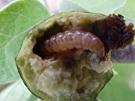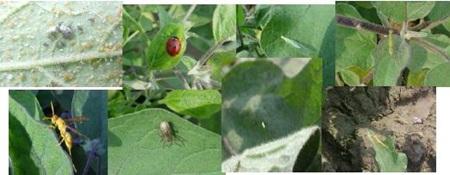IPM Strategies for Brinjal
IPM Strategies for Brinjal
Among various vegetables, brinjal is common and extensively grown all over the country. One of the major constraints identified in its production is the increasing incidence of insect pests, diseases and nematodes, sometimes resulting in substantial yield losses. Due to its tender and supple nature and its cultivation under high moisture & input regimes, brinjal is more prone to pest attack and at a conservative estimate cause about 35-40% losses.
Problems related to high use of pesticides
To mitigate the losses due to pests, a huge quantity of pesticides is used in brinjal.
- The vegetables which are harvested at short intervals are likely to retain unavoidably high level of pesticide residues which may be highly hazardous to consumers.
- The excessive reliance on chemicals has led to the problem of resistance, resurgence, environmental pollution and decimation of useful fauna & flora.
Key pests
Hadda beetle
Adults are pale brown and mottled with several black spots while grubs are yellowish in colour. Eggs are cigar-shaped, yellowish in colour and laid in groups. Grubs and adults scrap the leaves, feed on the green matter and totally skeletonise the leaves.
Aphids
 Nymphs and adults suck the sap from the leaves and the affected plants turn yellow, get deformed and dry away. Aphids also secrete honeydew on which sooty mould grows, which hampers the photosynthetic activity.
Nymphs and adults suck the sap from the leaves and the affected plants turn yellow, get deformed and dry away. Aphids also secrete honeydew on which sooty mould grows, which hampers the photosynthetic activity.
Shoot and fruit borer
 In the initial stages, larvae bore into shoots and the growing poi nt is killed. Appearance of wilted, drooping shoots is the typical symptom. Later larvae bore into fruits which become unfit for consumption.
In the initial stages, larvae bore into shoots and the growing poi nt is killed. Appearance of wilted, drooping shoots is the typical symptom. Later larvae bore into fruits which become unfit for consumption.
Red spider mite
Larvae, nymphs and adults feed on the under surfaces of leaves. Affected leaves gradually start curling and finally get shrivelled.
Phomopsis blight and fruit rot
On leaves, disease appears as circular brown spots. Pale, sunken spots develop on the fruit later, which enlarge and cover the entire fruit surface and the internal portion of the fruit rots.
Little leaf
 Characteristic symptoms are smallness of the leaves, shortening of the petioles and internodes of the stem and the leaves become narrow, soft, smooth and yellow. Plant appears like a bush. Fruiting is rare.
Characteristic symptoms are smallness of the leaves, shortening of the petioles and internodes of the stem and the leaves become narrow, soft, smooth and yellow. Plant appears like a bush. Fruiting is rare.
Sclerotinia blight

Downwards wilting of twigs occurs from top towards main stem. Fungal growth occurs near joints in severe cases. Finally whole plant wilts.
Root-knot nematode
The most characteristic symptom is the formation of knots or galls on the root system. Plants show stunted growth. Affected fields have patchy growth with poorly grown, stunted plants.
Integrated Pest Management strategies
Nursery
- Always prepare raised nursery beds about 10 cm above ground level for good drainage to avoid damping off etc.
- Cover the nursery beds with polythene sheet of 45 gauge (0.45 mm) thickness for three weeks during June for soil solarisation which will help in reducing the soil borne insects, diseases like bacterial wilt and nematodes. However, care should be taken that sufficient moisture is present in the soil for its solarisation.
- Mix 250 gm of fungal antagonist Trichoderma viride in 3 kg of FYM and leave for about seven days for enrichment of culture. After 7 days mix in the soil in a bed of 3 sq. m.
- Seed of popular hybrids like F1- 321 be sown in beds in the first week of July. Before sowing, seed be treated with T. viride @ 4 gm/ kg. Weeding should be done from time to time and infected seedlings should be rogued out from the nursery.
Main crop
- Bird perches @ 10/ acre should be erected for facilitating field visits of predatory birds.
- Delta and yellow sticky traps @ 2-3/ acre should be installed for hoppers, aphids and white fly etc.
- Give 2 to 3 sprays of 5 % NSKE against sucking pests.
- Sprays of NSKE also bring down the borer incidence significantly. Neem oil (2%) application is also helpful in reducing borer infestation, though marginally. If incidence of leaf hopper and other sucking insect pests is still above ETL, then apply imidacloprid 17.8 SL @ 150 ml/ha.
- Pheromone traps @ 5/ acre should be installed for monitoring and mass trapping of shoot & fruit borer Leucinodes orbonalis. Replace the lures with fresh lures after every 15-20 day interval.
- Release egg parasitoid T. brasiliensis @ 1 – 1.5 lakh/ ha for shoot & fruit borer, 4-5 times at weekly interval.
- Apply neem cake @ 250 kg/ ha (in two splits) in soil along the plant rows at 25 and 60 DAT for reducing nematodes and borer damage. Don’t apply neem cake when there is heavy wind velocity or temperature is above 300C.
- Clipping of borer damaged shoots and collection and destruction of damaged fruits i.e. clean cultivation helps in management of borer and phomosis disease effectively.
- If the borer incidence crosses ETL (5% infestation), apply cypermethrin 25 EC @ 200 g a.i/ha (0.005%) or carbaryl 50 WP @ 3 g/litre of water or endosulfan 35 EC @ 0.07%.
- Continuous cropping of brinjal leads to more borer and wilt infestation. Therefore, crop rotation with nonsolanaceous crops should be followed.
- Periodically collect and destroy the egg masses, larvae and adults of hadda beetle.
- Rogue out the little leaf affected plants from time to time.
- Use of green manure, mulching with polythene, soil application with bleaching powder will reduce the infection of bacterial wilt disease.
Natural enemies (beneficial insects)

Do’s and Don’ts
|
Do’s |
Don’ts |
|
|
Source : Extension leaflet of National Centre for Integrated Pest Management (ICAR)
Related Resources
Last Modified : 7/20/2020
Need for a shade house in raising horticultural cr...
This topic provides the package of practices for c...
This topic covers information about Clove Crop Sta...
This topic provides information related to cultiva...
